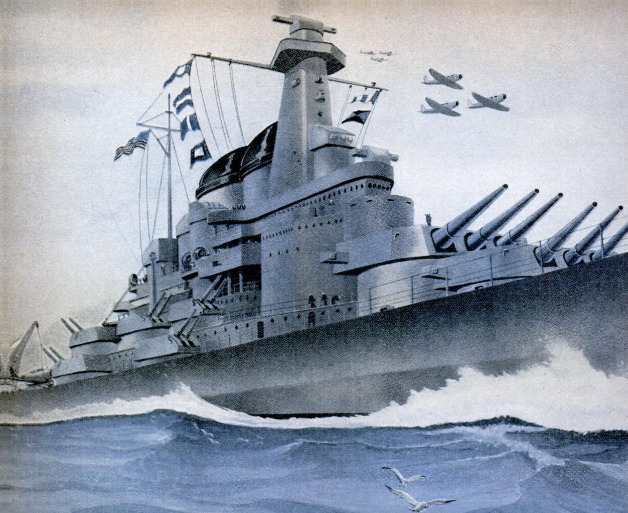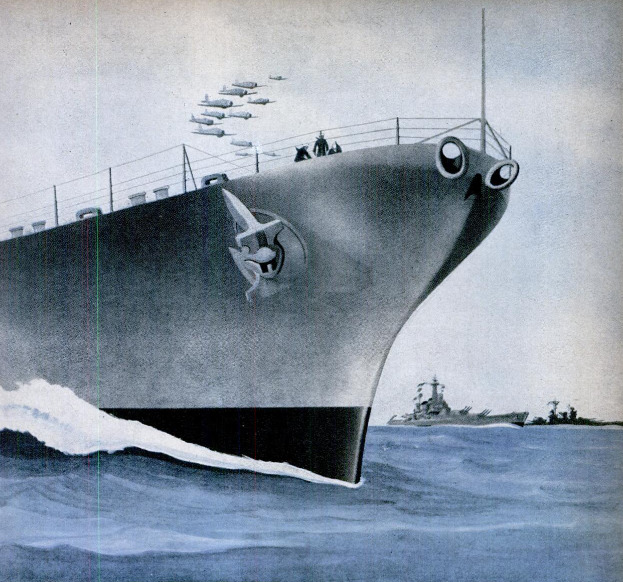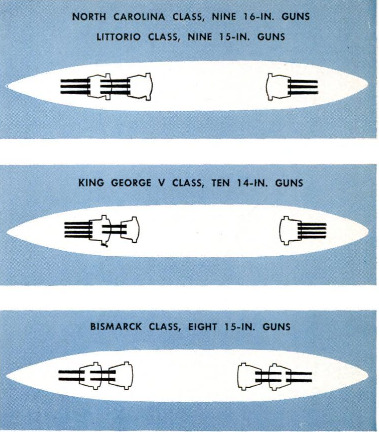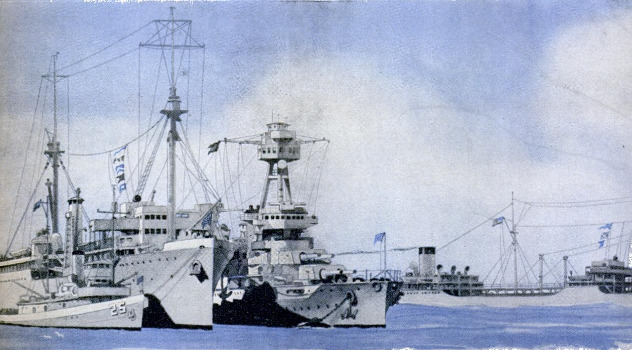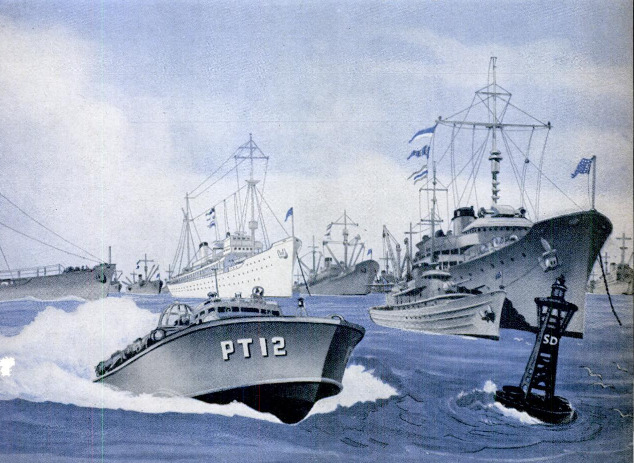-
Title (Dublin Core)
-
Navy's triple threat: fire power, speed and armor
-
Article Title and/or Image Caption (Dublin Core)
-
Title: Navy's triple threat: fire power, speed and armor
-
extracted text (Extract Text)
-
REINFORCING the United States Navy
at a time when they are extremely
welcome, the two most formidable
battleships in the world have just been
placed in commission. Sister ships of 35,000
tons each, the mighty North Carolina and
Washington excel anything else afloat in
their combination of guns, speed, and armor
—the three vital elements of a ship of
the line.
Nine 16-inch rifles belch a ten-ton broad-
side of steel and T.N.T. to a distance of
20 miles. A “designed” or rated speed of 27
knots keeps up with today’s demand for
faster and faster ships—and battleships,
like race horses, have a way of being con-
servatively rated by their owners before
they go into action. Either of the new ships
could be struck by as many as five torpe-
does and keep right on fighting, it has been
estimated, because of their antitorpedo
bulges and extreme subdivision into water-
tight compartments. “Belt” or side armor
reportedly 16 inches thick protects maga-
zines and machinery from shellfire, and ten
inches of deck armor resists the heaviest
bombs from the air.
Manned by 1,500 officers and men, each
750-foot floating fortress mounts three huge
turrets, of which the rotating part weighs
1,500 tons, or about as much as a modern
destroyer. Secondary and antiaircraft guns
embody latest designs—of which more later.
Three to four planes, launched from cata-
pults, spot artillery fire. Geared turbines
that drive quadruple screws consume
< enough power for Jersey City, N. J, or
Houston, Tex. A new steering system, with
twin rudders, is reported. Preparation of
thousands of working drawings for the
ships took two years in itself, and the result
is called the finest of 140 different kinds of
battleships. Owing to a changed method of
figuring tonnage, the Washington and North
Carolina exceed the size of their “43,200-ton”
namesakes which were scrapped when par-
tially completed, in postwar disarmament.
In hundreds of items, from sailors’ uni-
forms to superdreadnoughts, the Navy has
been modernizing itself for today’s style of
warfare. Sidelights as diversified as these
might be picked at random from a bulletin
board of recent naval news:
Sailors on shore leave no longer will ad-
vertise the whereabouts of any particular
warship by its name on their cap ribbons.
The words “U. S. Navy" are now being
substituted.
Because white uniforms have been found
t00 conspicuous aboard ship, the “camou-
flage” of khaki-colored working uniforms
has been adopted.
Records fall as construction leaps a year
‘ahead of schedule for battleships and nearly
as much for cruisers.
Veterans of Mississippi River traffic soon
will blink their eyes at the sight of U. S.
submarines, built at a Wisconsin shipyard
and traveling down OF Man River to the
Gui.
Lieutenant Commander J. J. Tunney, none
other than the Gene Tunney of heavyweight
boxing fame, takes charge of physical train-
Ing for Navy men, and officers keep fit with
an exercising machine of his invention.
Vessels of the Atlantic Fleet get a new
war paint of darker gray.
Crews of “mosquito” patrol torpedo boats
devise hand signals for maneuvers at 72
miles an hour, a pace that outrules the
traditional signal flags.
Latest of the Navy's long-range patrol
‘Bombers mount three power-driven gun
turrets, a system inspired by war ex-
perience abroad.
Dozens of private yachts, sold or pre-
sented to the Navy, join the sea forces as
gunboats, sub chasers, and patrol boats. A
car ferry becomes a mine layer.
"Plans advance for converting cargo ships
Into miniature aireraft carriers.
Radio-controlled planes simulate dive
bombers for Navy target practice—and are
brought down with gratifying frequency.
New and secret inventions detect sub-
marines, warn of approaching ships and air-
craft, and aid in high-speed mine sweeping.
Variable-pitch propellers for warships are
being developed. Like airplane propellers,
they automatically change their “bite” in
accordance with load, assuring maximum
efficiency at all times.
Here is some bigger news: According to
Rear Admiral S. M. Robinson, chief of the
Navy's new Bureau of Ships, three out-
standing developments—protection against
magnetic mines, more and better guns, and
antiaircraft measures—have transformed
what naval men now call the “old” fleet
of July, 1940.
Working swiftly and quietly, naval ex-
perts had 319 U. S. warships and auxiliaries
fitted to neutralize magnetic mines by as
early as February of this year, and work
on 115 more vessels was under way. The
system encircles a ship with a band of wires
carrying electric current, which counter-
acts the magnetic effect of the metal hull
and keeps the mines from exploding. A
curious phenomenon in that magnetic com-
passes go awry when the device is turned
on, but this does not matter to modern ships.
equipped with gyro compasses, which are
unaffected,
First installations of the antimagnetic “de-
gassing girdle” —named after the gauss,
a magnetic unlt—were temporary. Early
thin year, the Navy perfected a permanent
de-gaussing system, costing an average of
$20,000 per vessel, that will be good for
the life of the ship. Replacements will bo
made as vessels come In for overhaul, but
already the Navy feels satisfied that It has
conquered the magnetic-mine menace.
Guns for warships, guns for some 115
naval auxiliaries that go unarmed in
“normal peacetime,” still more guns for
vessels taken over from commercial mervice
—these have been another key part in
putting the fleet on a war footing.
Pride of the Navy is its new five-inch gun
for destroyers and, as secondary armament,
for cruisers and battleships. This double:
purpose weapon can be trained on sea
targets, or elevated to extreme angles for
antiaireratt fire. Turrets mount the guns
in pairs. They supersede a shorter-barreled
five-inch gun, which in turn replaced a
three-incher. Remarkable range and rapldi-
ty of fire distinguish the newest guns. Be-
sides installations on battleships, they have
been placed on the latest crulsers and on
all destroyers. They may clearly be seen in
the painting of the North Carolina on pages
86 and 87, installed at two levels along the
side of the ship,
For defense against dive bombers, the
U. S. Navy has developed a new 1li-inch,
‘multiple-barreled pom-pom gun or “machine
cannon,” according to Rear Admiral W. R.
Furlong, chief of the Navy's Bureau of
Ordnance. A burst of its ultra-rapid fire
fills the air with explosive one-pound shells,
capable of winging or completely demolish- |
ing a plane with a single hit. Four to eight
of these deadly batteries, placed at stra-
tegic posts on the topside, go into action
under centralized director control. First
deliveries have been slower than the Navy
would like, but it expects to get at least 400
of the guns this year.
“Splinter protection,” the third main ad-
vance, shields formerly exposed members
of the crew from fragments of bombs, and
from pieces of steel that a bomb may knock
off. The war has shown this flying debris
far more dangerous to personnel than had
been expected. Therefore, as much topside
armor as can be installed, without impair-
ing the stability of the ship, has been
adopted to protect U. S. gun crews, ob-
servers, and signalmen. As this is written,
most of our 58 large warships, including all
battleships, have been fitted with splinter
protection.
New ideas in power plants occupy a
prominent place among other modern naval
developments, Operating under 600 to 800
pounds of steam pressure, compared with
the 150-pound pressure of most ships in the
last war, the North Carolina and Washing-
ton are our first battleships employing the
high-temperature, high-pressure systems al-
ready tried out successfully in smaller U. S.
warcraft. Diesel engines for major war-
ships, introduced in the German pocket
battleships, are rated as a development
worth watching. And within a few months,
the Navy is Scheduled to receive a gas
turbine, which, according to Admiral Robin-
son, “is revolutionary in design and promises
a new era in power for propulsion of ships.”
It will be subjected to extensive trials, first
in the Engineering Experiment Station at
Annapolis and then in a ship. As many
readers of this magazine will recall, a gas
turbine works much like a steam turbine,
but the steam is replaced by a searing blast
of vapor from ignited fuel. Practical dry-
land power plants using gas turbines have
been developed only within the last few
years (P.S.M., Dec. '39, p. 80), and use of
a gas turbine to propel a warship would be
an innovation of the first magnitude.
What the Navy calls a “projectile pro-
gram” has been carried on for three or four
years. Improved naval shells have been
produced by special heat treatment, which
prevents the missiles from breaking up
when they meet their mark. As Admiral
Furlong puts it, “It gives you the ability
to pierce a given thickness of armor plate
at a much greater range.” Providing battle-
ships with 16-inch and 14-inch armor-pierc-
ing shells of the new type has come first
in the program, which also includes eight-
inch shells for the guns of heavy cruisers.
“A recent experiment where one of our
battleships actually fired on another one,”
Admiral Furlong says, “clearly showed that
improvements could be made in the con-
struction of gun turrets.” Not officially
identified in this startling statement, the
target ship may have been the radio-con-
trolled Utah, capable of operating without
a crew aboard. The Navy is taking ad-
vantage of the test's results on each battle-
ship and cruiser in service. What they
were remains its secret.
Among the most novel of fighting ships
under construction and on order for the
Navy will be our first battle cruisers—the
recently contracted-for Alaska. Samoa,
Havwaii, Philippines, Puerto Rico, and Guam.
From their cost of $53,400,000 apiece for
hull and machinery alone, the only detail
made public, naval experts guess them to
be ships of between 25,000 and 27,500 tons,
mounting 12-inch or 14-inch guns. If so,
they will be comparable to the German
ships Scharnhorst and Gneisenau, which
have been used as fast sea raiders.
What distinguishes a battle cruiser from
a battleship of equal gun power is superior
speed, gained at the sacrifice of a battle-
ship's massive armor. And now that engi-
neering advances have given modern battle-
ships what used to be considered battle-
cruiser speed, the latter will have to be
stepped up in turn. When the new 35,000-
ton German battleship Bismarck met Eng-
land's 42,100-ton battle cruiser Hood, since
1920 the world's largest warship, the contest
was equal in guns and speed—but the Hood's
armor failed to stop a shell that exploded its
magazine and sank it. Presumably the new
American battle cruisers, capable of de-
stroying pocket battleships and cruisers,
will have exceptional speed to keep out of
the way of more powerful adversaries—
which will have to be dealt with by our
battleships.
Arrangement of big-gun turrets offers a
striking example of changing naval designs.
For American battleships, which formerly
carried equal armament fore and aft, the
North Carolina class represents a new
departure. It concentrates two thirds of its
guns in forward turrets, giving added fire
power on the offense,
Comparison suggests itself with the new
35,000-tonners of foreign design. Italy's
Littorio class has a similar arrangement of
turrets, but inferior armament—nine 15-
inch instead of 16-inch guns.
England's King George V class adopts a
different method to bring the most intense
gunfire forward. Quadruple 14-inch gun
turrets fore and aft are reinforced by a
pair of guns of the same size in a second
forward turret.
France's ill-fated Richelieu class repre-
sents an all-forward turret arrangement,
unique except in Britain's smaller Nelson
and Rodney. Even before the war, British
naval maneuvers demonstrated its danger-
ous weakness in leaving the stern unpro-
tected. The battered Richelieu, last re-
ported in use as a floating battery, mounted
eight 15-inch guns in quadruple forward
turrets.
Germany's new Bismarck class carries the
same armament in two turrets forward and
two aft. Japan's smaller Nagato class
mounts eight 16-in. guns, similarly dis-
tributed.
A glance over these figures will clearly
show the superior armament of the U. S.
35,000-tonners, with Britain's a good second,
as measured by the total power of their
guns. The American ships even have the
greatest total diameter of guns; and a pro-
Jectile’s bulk increases so rapidly with di-
ameter that a 16-inch shell weighs half
again as much as a 14-inch shell.
In the U. S. battleship program, four more
of the North Carolina class are building, and
due for completion next year. They will be
followed by six even mightier 45,000-ton
craft of the Iowa class. These 880-foot
ships, designed to equal or outclass Japan's
much-rumored vessels of 40,000 tons or
more, will use their added tonnage for
speed. Keels have been laid for four of
them. Thirty percent of their steel work
will be welded, saving still more weight
for propelling machinery, which is rated at
the unheard-of figure of 200,000 horsepower
—which is nearly twice that of the North
Carolina.
If that seems like something, hold your
hat. Five more U. S. battleships of the
Montana class, all contracted for, will dis-
place 58,000 tons apiece. Superdreadnoughts
seems a mild word for them. Probably too
gigantic to risk launching by sliding down
shipbuilding ways, they may be set afloat
in special shipbuilding basins—another sub-
ject upon which the Navy prefers not to
elaborate. For armament, twelve 16-inch or
18-inch guns are talked about. To naval
architects these will be “dream ships,”
virtually ending decades of compromise in
apportioning weight for guns, armor, and
propelling machinery. Hulls of such mon-
ster size will carry all that could be desired
of each. The result will be the long-pre-
dicted “ultimate” or ideal battleship, the
monarch of the high seas.
And, as someone has said with grim
humor, “People understand battleships.”
-
Contributor (Dublin Core)
-
Alden P. Armagnac (article writer)
-
Language (Dublin Core)
-
Eng
-
Date Issued (Dublin Core)
-
1941-08
-
pages (Bibliographic Ontology)
-
86-91
-
Rights (Dublin Core)
-
Public domain
-
Archived by (Dublin Core)
-
Sami Akbiyik
 Popular Science Monthly, v. 139, n. 2, 1941
Popular Science Monthly, v. 139, n. 2, 1941

